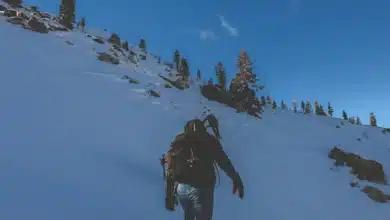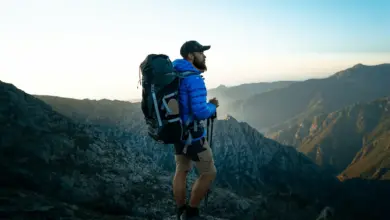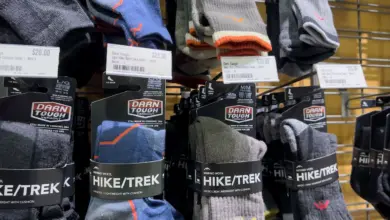What Do I Need to Get Started Snowshoeing?
I remember my first time snowshoeing and having the same questions as you, “how do I snowshoe?”, “what size snowshoes do I need?”, “do I need special boots for snowshoeing?” And what I found is that snowshoeing is actually pretty easy and doesn’t take any special skill. It’s so easy in fact, that you might think you’re doing something wrong when you’re not. So I decided to put together a snowshoeing guide for beginners to help you get started.
What Do I Need to Start Snowshoeing?
What you need to get started snowshoeing is pretty similar to what you would need to get started hiking in winter, for one difference, a pair of snowshoes!
What you’ll need to snowshoe are:
- A pair of snowshoes
- A pair of poles
- Waterproof winter boots (no sneakers!)
- Gaitors are helpful but optional
- Winter clothing to keep you warm and dry
If you have never snowshoed before or done any outdoor activity, you’ll want to learn how to layer yourself properly. I usually a layering system when hiking, and add and remove layers depending on my body temperature. It’s important not to overheat as you’ll be doing a lot of activity.
As for what pants to wear when snowshoeing, I like to wear hiking pants with a pair of thermals or long underwear underneath. Whatever pants you choose to wear, they should be either waterproof or quick-drying. It’s best to avoid cotton, which means no jeans.
Some people often ask if they can snowshoe in ski boots. The answer is yes, but it really depends on what kind of ski boots you have and if you are comfortable walking in them. The more flexible the boot, the better. Another thing you want to make sure is that the ski boot actually fits inside the snowshoe bindings. Oh, and keep in mind you’ll be using more energy to carry the extra weight. In any case, it’s best to test it out beforehand to judge your comfort level before going on any big trips.
How Do I Snowshoe?
As the saying goes, if you can walk, you can snowshoe, and it’s pretty much true! Snowshoeing does require some technique at times, but it’s also a lot more simple than people think.
To snowshoe, you’ll want to walk like you normally would, but keep a slightly wider stance to prevent the snowshoes from bumping into each other. You’ll also be using your poles for balance and to take some weight off your legs.
How to Snowshoe Uphill (Ascending)
Going uphill in snowshoes is just like going uphill when you’re walking. A lot more weight will be near your toes and you’ll be leaning forward slightly. When you’re doing this, you’ll be relying a lot on the crampons on the snowshoes.
Before you climb, take a moment to shorten your poles. When climbing, you’ll want to kick your feet into the snow to get a better grip. Don’t be afraid to dig in, it will actually help you. For extra hard snow or steeper slopes, take shorter steps and take your time.
How to Snowshoe Downhill (Descending)
When snowshoeing downhill, you’ll want to be a little more careful, especially on any icy parts. Instead of relying on your toes when going uphill, you’ll have more weight shifted toward your heels.
Before you descend, take a moment to adjust your poles so they are longer. Poles will help you keep your balance.
You may also like Winter Sleep Systems
Breaking Trail in Deep Snow
There may be times when you are snowshoeing in deep snow and need to “break trail”. Breaking trail is packing the snow down to make it easier to hike on. This is a lot more labor intensive but can be made a little easier with help.
When you are breaking trail as part of a group, form a single line, one behind the other. This will make it easier for everyone. As the person in front becomes tired, have someone else in the group take their place to keep a steady pace.
Using Poles While Snowshoeing
Poles aren’t technically required to snowshoe, but they sure do come in handy. They not only provide balance, but they also divert some energy away from the legs and to the arms, and are especially useful when climbing hills.
Here are some tips when using poles for snowshoeing:
- When using poles, adjustable poles are best, as they can be shortened for uphill and lengthened for downhill.
- Pole length should be adjusted so that your elbow is bent at a right angle, with your forearm parallel to the ground.
- Using pole straps will allow your wrist to rest on the strap so that your hands don’t need to grip the handle as much, giving your hands a break.
Trail Etiquette
When snowshoeing, you may be sharing the trail with cross-country skiers. If you come across a path on the trail that has been used by skiers, try to make your own snowshoe path off to the side to prevent ruining the ski tracks. If you do cross paths with skiers, step aside to let them pass. It’s much easier for a snowshoer to step aside than it is for a skier.
What Should I Bring When Snowshoeing?
There are some important items you should carry with you in your day pack when you go snowshoeing. Before you rush out and hit the trail, there are a few things to know and bring on your snowshoe trip. Be sure you should know how to hike safely in winter and have an understanding of trail skills. You’ll also want to be dressed appropriately, which means having waterproof boots and a layering system.
Here is a snowshoeing checklist:
- Water bottle
- Insulated thermos with a hot beverage
- Trail snacks/lunch
- Extra jacket/insulation layer
- Simple first aid kit
- Headlamp (I always carry two light sources)
- Trail map and compass
- Emergency Whistle
- Handwarmers
- Orange hiking vest for hunting season
- Extra pair of gloves and socks inside ziplock bags
You may also like Best Safe Tent Heaters
Beginner Snowshoe Tips
There are a few tips that can make snowshoeing for your first time easier. With anything physical, it’s best to start small and work your way up.
If it’s your first time, try a shorter trail that’s flat. Before you go, you might even want to test out your gear on a short hike or walk around your neighborhood. After your hike, you might experience some soreness in your hips and groin muscles.
Take your time, bring a friend, and have fun!
How Do Snowshoes Work?
Snowshoes work basically by distributing your body weight over a greater area of snow, preventing you from sinking in as far. This quality of distributing weight over the snow is called “flotation”. The larger the snowshoe, the more effective it is and the greater the flotation it has.
The opposite of flotation is called “postholing”. This happens when your foot sinks right into the snow causing a hole. This might not seem like a big deal, but it wastes a lot of energy and is considered poor trail etiquette. Other hikers could fall into the hole and it creates an uneven surface for other hikers and skiers.
How Much Snow Do You Need to Snowshoe?
While there is no official number, generally, 6-8 inches of snow is the minimum amount of snow to snowshoe in, preferably more. If there is not enough snow, rocks and other debris could damage the snowshoe.
When you are hiking with snowshoes, it might not make sense to wear snowshoes for every part of the trail. Don’t be afraid to take off your snowshoes where there is little snow, where the snowshoes could get damaged, or where you need more aggressive traction devices like crampons.
If you do take off your snowshoes, make sure they are fastened securely to your pack, making sure they don’t bounce around.
You may also like Can You Snowshoe with Your Dog?
Can I Snowshoe with My Toddler?
While snowshoeing is great, a lot of people are wondering if they can snowshoe with their 2 or 3-year-old. The answer is yes! Snowshoes come in all sizes and if your child is old enough to talk, chances are there are snowshoes that will fit him or her. I’ve even heard stories of 20-month-old children snowshoeing!



